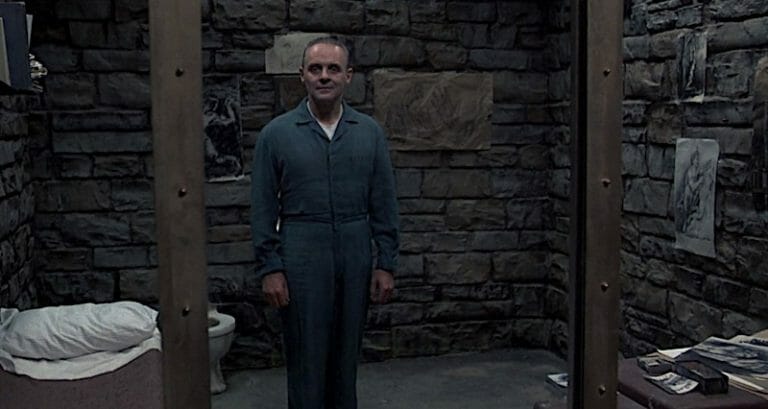By Ken Miyamoto · June 5, 2019

What are some simple screenwriting secrets that screenwriters can use to terrify the audience in their horror and suspense thriller scripts?
Welcome to our ongoing Learning from the Masters and Industry Insiders series where we seek out and feature excellent videos, interviews, and discussions of the art, craft, and business of screenwriting and pull the best words of wisdom, writing tips, and screenwriting advice.
Here we turn to the Academy Award-winning suspense thriller Silence of the Lambs for some answers on how to inject terror into the minds and hearts of the audience. The Closer Look‘s video essay on how to terrify the audience uses the film’s iconic scene of Clarise’s first meeting with Hannibal Lecter as an example.
Download the screenplay for SILENCE OF THE LAMBS here for free
A lesser version of the film would have opened with Hannibal Lecter in his earlier pre-capture days ravaging a victim, followed by a cut to years later showcasing him imprisoned and being pursued by a young FBI agent to help with a case.
Instead, the script and eventual film decided to build the audience’s anticipation masterfully.
Lecter is referenced in the opening scenes of the film by authoritative characters stating how dangerous, menacing, and evil he is. Keep in mind that at this point, we know nothing about Lecter. But two characters that showcase authority on the subject — an FBI director and a Criminal Psychiatric Institution doctor — build anticipation by decrying how dangerous this character indeed is.
Once that anticipation is built, it informs every scene that comes before the reveal of the character.
In Jaws, we see the wrath that this unknown and unseen monster of the sea can unleash. But for a majority of the film, we never lay eyes on the shark.
In Alien, the xenomorph is always kept within the shadows. We see the result of its horrific capabilities, but it’s not until much later that we actually see the alien threat in full form.
Silence of the Lambs manages to conjure these feelings of anticipation through psychological anticipation.
As Clarice enters the long, stone cell block, she must pass three other seemingly dangerous beings before we reach the “monster” she’s been hearing about.
We see a creepy figure smiling at her in the first cell.
In the second cell, we see a lifeless figure staring just past her.
In the third cell, we’re jolted as we see a crazy human being climbing bars like a crazed animal.
So the anticipation builds and builds and builds. If these three intimidating characters are ones that she hasn’t been warned so much about, what will Hannibal Lecter be like?
And then she reaches him. He’s calm, cool, collected, polite, well-spoken, and articulate. This shatters our imagined image of what he was going to look like. And now, the anticipation grows tenfold with every moment of the film because we’re waiting for this “monster” to show its true self.
Anticipation is everything in horror movies and suspense thrillers.
Despite Lecter being imprisoned, he has all of the power over Clarice. She needs his help, and he doesn’t want to offer any — at least not until he gets something in return.
The video essay makes an excellent point regarding power as it compares the original Alien to its sequel Aliens. In the original, the crew being threatened is made up of non-military pilots and mechanics. These are blue collar workers with no weapons and no expertise in fending off any foes.
However, in the sequel, the protagonists tasked with facing the aliens are military space commandoes with all of the weaponry they need to take on any force. Yes, they eventually learn that the foes they are facing are unlike anything they’ve ever gone up against, but the point is that the original film was scarier than the second because the alien had more power over the crew — compared to the space commandoes and their arsenal and expertise in handling threats.
In Jaws, the power the shark had over the humans was his ability to disappear within the depths of the ocean waters. He could come and go without being seen and without ever leaving any trail for the chief and his companions to follow. Even when he was tagged with barrels, he had enough power to disappear underneath the surface of the water and into its depths.
In A Nightmare on Elm Street, Freddy Krueger had power over all of the teenagers because the dream world was his domain. He could do anything. It wasn’t until they took him out of the dream world when they could destroy him (temporarily).
So when you’re developing the threats within your horror and suspense thriller scripts, be sure to give all of the power to them. At least for the first two acts.
Download the screenplay for A NIGHTMARE ON ELM STREET here for free
Watch the whole video essay below!
For all the latest from The Script Lab, be sure to follow us on Twitter, Facebook, and Instagram.
And become a member of TSL 360 to enjoy the LARGEST screenwriting education content library, featuring masterclasses, deep-dive interviews, and lectures from Academy Award-winning screenwriters, TV show-runners, producers, literary managers, agents, studio executives, and leading educators – all in one place.